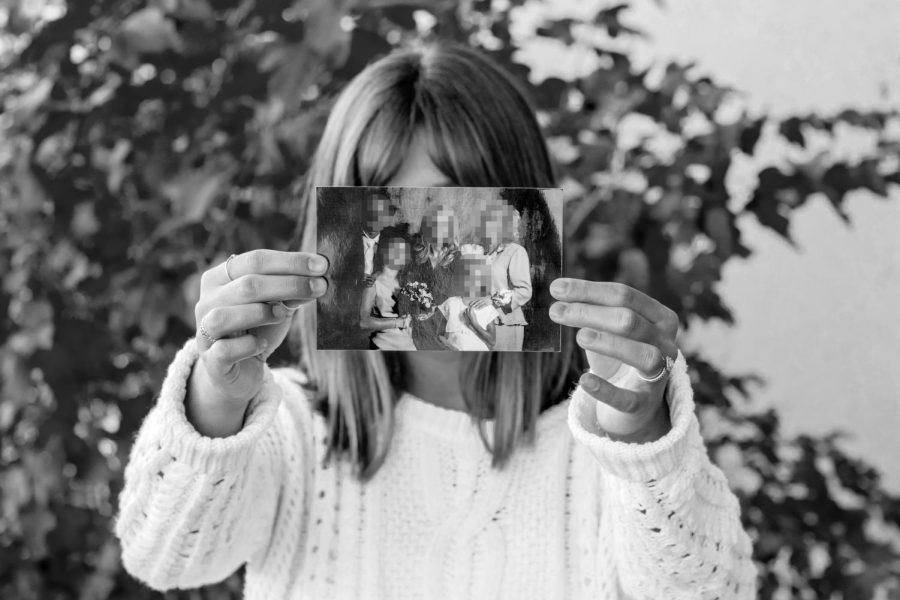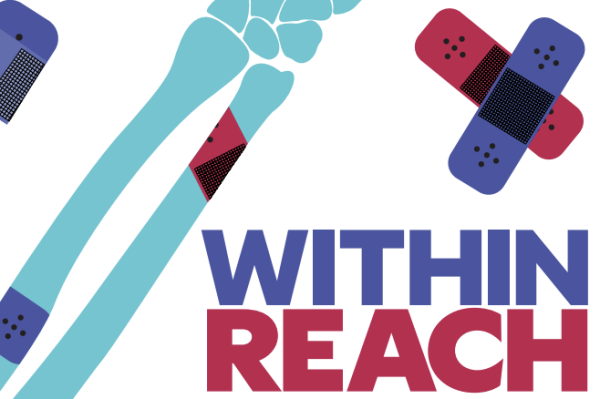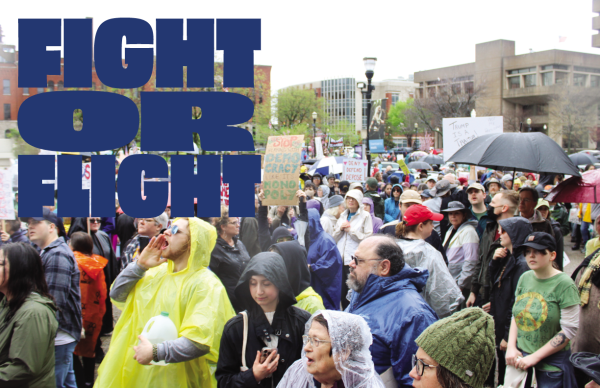The Silent Cycle
There are over 22,000 reported cases of kids suffering from abuse in our state. Here’s one girl’s story.
Photos by Lainey Holland
The subject of this domestic violence story holds up a blurred family picture.
SENSITIVE CONTENT WARNING: This article contains content about child abuse that some may find disturbing.
A Note From the Editor: The names in this story have been changed to protect the identities of the victims. OTR verified accounts through court records and arrest reports.
Wheels rolled up to the driveway of their house, making pops where rubber turned on broken cement. Emma Brooks sat in a car seat next to her big sissy, Teresa Smith. Emma was at an age where she would hold up three fingers to answer people when they asked, “How old?” Her sister, Teresa, had run out of fingers the last year.
A series of indecipherable flashes erupted. Gunshot number one came from the backyard. Gunshot number two came from familiar hands. After gunshot number three, the car began rolling in reverse, faster than they had rolled in.
Suddenly those flashes led to a dark, malicious red — a red that covered the three-year-old’s hands too heavily. As the velvet stains covered her hands, she recalled the words:
“What’s wrong with sissy?”
It was July 26, 2000. Emma’s biological father, Jack Smith, had threatened to murder her mother. Instead, a friend of Jack fired shots at the car. The assault left Teresa blind, mentally handicapped, and partially paralyzed in her left arm.
Nineteen years later, Emma sat isolated in the corner of a party with her friends. People in uncomfortably-close proximity emitted a thick, sour stench of alcohol. She didn’t have to consume alcohol for the chemical to affect her. Emma’s brain switched its channel from the present to a rerun. The familiar smell immediately triggered the episode she’s lived over and over again.
Emma hyperventilated; her heart was under the impression that she must run for her life. Eyes sore and face discolored, Emma ruminated over one of the many moments when her life was rerouted by abuse. Nineteen years later, she still has nightmares of the dark, red color.
Emma found herself tracing over her hands as if the stains never went away. And in some ways, they never would. Tears painted her cheeks as she struggled to make sense of what she just relived.
To reveal the facts of that night, we (writer Maddie, along with two OTR editors, Ysa and Ella) uncovered Shelby County Civil Court records and arrest citations. A friend of Jack, who actually shot at the car, pled guilty to first-degree assault with a deadly weapon. But Jack’s charge showed terroristic threatening, a Class A misdemeanor, for threatening to kill her mother with a rifle earlier the same day. In our research, we confirmed that Jack possessed a lengthy criminal record spanning over two decades for charges from assault to driving under the influence — a violent pattern that corresponded with the timeline of the sisters’ allegations of abuse.
His actions left the family with a lifetime of ongoing recovery from signs of post-traumatic stress disorder (PTSD), anxiety, and other mental health issues. Every day, Emma says she navigates triggers that can send her back to past traumas. The flashes come in fragmented pieces, difficult to put together into a full memory. These episodes come from years of repressing memories.
A Harsh Reality
“I know four close family members, three extended, and five friends that have experienced abuse,” Emma said.
In the United States, nine out of every 1,000 children will become victims of child abuse. In Kentucky, that rate is even higher. Our state, as of 2017, has the highest rate of child abuse in the country — 22.2 of every 1,000 kids, more than double the national average.
If child abuse is so common, especially in Kentucky, why aren’t we talking more about it? Many of the kids in these dangerous environments are the only ones who can tell their stories, but, because of their vulnerability, they are often silenced.
“I was always really afraid to tell people because I felt like they would think I was crazy,” Emma said.
According to a report from the U.S. Department of Health and Human Services, child abuse can cause lifelong trauma. In 2017, 10 children died from child abuse in Kentucky. Circumstances like these, while rare, demonstrate why it’s so important to get kids out of abusive environments and into help as early as possible.
Child abuse is a pretty broad term, but, according to the U.S. government-run Child Welfare Information Gateway, it specifically includes “any recent act or failure to act on the part of a parent or caretaker which results in death, serious physical or emotional harm, sexual abuse or exploitation.” A “child” under this definition means a person who is younger than 18.
Emma and Teresa lived the truth of this definition, saying they were verbally and emotionally abused by their biological father, but also scarred from witnessing the physical, verbal, emotional, and mental abuse against their mother.
“I remember sleeping in the car sometimes because we were scared to go home,” Emma said.
In another instance, Jack attempted to explain away a burn on Emma’s cheek, saying she “walked” into his cigarette butt. It left a scar on her cheek for years.
“He would just threaten with knives, and wear big boots, and he would kick her,” Emma said recalling witnessing the abuse of her mother. “She would just tell us to go to the bedroom, and sometimes we’d call the cops, and it would be a big ordeal in the neighborhood.”
Emma says she continually experienced trauma experiences during visitation with Jack — visitations that were still ordered even after her sister was shot.
The Next Chapter
After Teresa was shot, she was flown into Norton Children’s Hospital in downtown Louisville and hospitalized for four months.
“They told my mom originally that she wouldn’t live because the way the bullet hit her in the brain,” Emma said of her sister. “The bullet is still in her brain, fragments of it.”
Their mother stayed at Teresa’s side for the majority of her recovery, along with close friends and family, including their pastor’s family from their church in Shelby County.
“The small church that my mom and I grew up in, the pastors would come and speak to my mom and kinda help my mom, because she felt like she had to fight the doctors,” Emma recalled.
During this time, Emma moved between houses of close relatives along with her 18-year-old brother. He was separated from many of the situations as he was not a part of the shooting, but he suffered a life with Jack even longer than Emma did.
“He was actually the one who told my biological father to leave and never come back,” Emma said.
After her brother stood up to Jack, he and Emma were referred to the Ronald McDonald House by Kosair.
“The location is right next to the hospital, so it provides a home away from home that’s close to your family which was really helpful for us,” Emma said.
Emma and Teresa’s biological father faced charges for terroristic threatening, typically a five to 10-year sentence, of which he served even less than the minimum. Aside from the time he was in jail, the family still feared for their safety. After leaving the hospital, the family lived on a fixed low income. Their only option for shelter was the same home in which they had suffered abuse for years. Going back to that house was dangerous, and put the family through even more trauma when Jack was released from jail.
For example, Emma has a resurfaced childhood memory of laying belly to carpet, leaning on her elbows as she colored in and outside the lines. Her momentary peace was interrupted by screaming and banging, followed by Emma’s biological father breaking down the front door. Jack had just been released from jail, and the house was under his name.
The circumstances forced Emma’s family to leave.
Emma doesn’t remember all of the accounts like these, but some of them resurface in flashes.
“Eventually after that night when he broke down the door, after the shooting, me and my mom and my brother lived in a government apartment,” Emma said. “It was the only way to get away from him.”
In the years after this, Emma and Teresa visited Jack in legally-required, supervised visits a few times per year.
“I remember seeing my biological father some throughout those years because in court, my mom offered him the house and all the money and everything in exchange for sole custody of me and my sister,” Emma said. “He chose to take all of that instead of the kids. But, they still ordered visitations … The judge made it okay for us to have to visit him even after all that.”
These visits led Emma to repress her feelings.
“I would pretend like everything was okay even though I knew it wasn’t okay,” Emma said.
In 2009, when Emma was 11 years old, Jack took her and Teresa away during one of their regular visits. The visits were required to be supervised by another adult, usually a family member, but this time no one was watching, leaving the girls defenseless with their biological father.
He lied about why they had to leave their visiting location and took them to Bloomfield, Kentucky, an hour away. Emma hadn’t realized he had no plans of taking them back. They pulled up to a trailer where their biological father and his girlfriend were staying. When they arrived, there was no cell signal, no connection to safety.
“He was fine, and we were laughing about stuff, and he just started acting really weird and he started yelling at me and asking me why I didn’t drive,” Emma said, voice breaking. “Now I know that he was diagnosed with mental illness, but then I didn’t know that, and I wasn’t fully aware of the drugs and the drinking and stuff.”
Emma was able to find cell phone reception later in the night, contacting her mother, and eventually returning to her “real” family, her mother and stepfather.
For years, the girls still visited their abuser and his extended family, staying silent about their history. It wasn’t until adulthood that Emma and Teresa were able to choose to stop seeing Jack.
“He would make a big deal about us going to his family things, so I would go to his family Thanksgiving, hide in the bathroom and cry there,” Emma said. “I would just pretend like everything was okay on the outside but there wasn’t really a lot I could do.”
Although Emma now refuses to see her biological father, she relives memories of life with him every day. As a recent graduate from the University of Louisville nursing program, she’s moving forward with her life, but her career is not an escape. Emma described treating a patient whose circumstances triggered her traumatic memories.
“She wrote down on a piece of paper that her husband had hurt her mentally and physically,” Emma said. “She tried to show bruises on her wrists and stuff.”
Emma felt that their similar experiences connected them and she believed the woman was telling the truth.
“Her daughters were taking the dad’s side and calling her crazy,” Emma said. “It was really frustrating to me because she was so emotional.”
Even the suggestion of reconnecting with her biological father sends Emma into a state of panic and anxiety. Some people in her life are left with the impression that her trauma isn’t affecting her to this extent.
This miscommunication is a direct result of the isolation Emma mentions in her personal definition of domestic violence: “Any situation where, not just physical abuse but also verbal abuse, isolation, manipulation — it starts with that stuff, the isolation and manipulation,” Emma said.
Isolation is a common, powerful, and dangerous weapon of abusers. It’s the weapon that continues the cycle of abuse, pressuring victims into silence. Emma fights this feeling to sustain the fulfilling life she strives for.
It’s not only her battle, though. It’s the battle of countless victims around the state. It’s the battle of any citizen who wants to create a future free from abuse. Your part in ending the silent cycle is doing the very thing every abuser fears the victim will do — speak out.
What’s Your Role?
According to a report published by the National Center for Biotechnology Information, abused teens may not always report their abuser. Individuals 12 to 19 years of age only report about one-third of crimes against them, compared with one-half in older age groups.
This makes it important for outsiders to understand the signs.
Physical signs of abuse can be injuries like burns, bites, bruises, and swelling that can’t be explained, frequent physical complaints (headaches, stomach aches), and signs of injuries that weren’t properly treated.
Behavioral signs include a child seeming afraid of their parents, always acting very cautious as to not upset them, and protesting returning home. It’s important to remember that these signs are not always so clear cut. The situation is different for every person.
Keep in mind that if you believe that a child is being abused, Kentucky has a mandatory reporting law that requires that you alert the authorities. A call to 911 can begin the process of getting children the help they need.
Although circumstances vary for every victim, Emma is able to find help by connecting with others. Emma was able to share her experience with her best friend, another survivor of abuse and her peer in nursing school.
“We really connected because she was so open about everything that she’d been through,” Emma said. “She helped me get comfortable talking about it and get comfortable with the idea that it’s okay not to be okay.”
Getting out and getting help is one of the first steps to breaking the cycle of child abuse. Studies show that 80-90% of domestic violence victims end up abusing or neglecting their own children because of their increased risk for PTSD, aggressive behavior, anxiety, and substance abuse. Survivors who seek therapy for their trauma have better odds of overcoming their abuse. If you know a survivor of abuse, your role in encouraging them to seek help can make the often isolated road to recovery feel more comforting, affirming, and rewarding.
If it wasn’t for the encouragement of her husband, Jeffrey Brooks, Emma may not have reached out for help. Because of his pushing, Emma agreed to go to therapy at Southeast Christian Church for six months.
“I didn’t start going until I was 20,” Emma said. “Before that, I thought I was fine. I repressed it so much that I almost forgot about it.”
Jeffrey believes that therapy has allowed her to share her wounds and help her become herself again.
“I want her to have the tools and the things to get through her situation,” Jeffrey said. “I support her no matter what.”
Emma doesn’t just represent victims of child abuse. She represents the upstander, a victim who is making active efforts to grow through past pains by speaking out against her abuser and others. Emma is especially focused on breaking the silence that follows abuse. And she doesn’t do this on her own.
The support of her family and friends with similar stories continuously proves to Emma that she is not alone.
“We all fall short, but when we have people on our side, it’s just another great reason to keep on going,” Jeffrey said.
The future can seem dark and hopeless coming from such a heavy past, but Emma has hope. She looks forward to the future she has in making new relationships with people, loving her friends, and bringing a new family into the world.
“I know for some people, it makes it hard because people have a fear of being like their abuser. But I feel like it’s made me more excited, because I can be different,” Emma said, revealing dimples from the sides of her cheeks.
Donations are collected through The Publishers, duPont Manual High School's booster club for J&C. On The Record relies completely on sponsorships, advertisements, and donations to produce and distribute each issue. Please consider donating to our cause, and helping the student journalists of OTR amplify youth voices for years to come.









